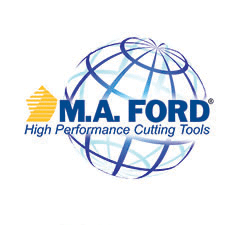
High performance cutting tool manufacturer M.A. Ford Mfg. Co. Inc., Davenport, Iowa, recently expanded its TuffCut® XT high performance Series 278 endmill product offering. More than 400 product line items have been added to include additional lengths of cut, corner radii and Weldon flat options. The corner radius offering is said to meet the needs of the aerospace manufacturing industry.
M.A. Ford's TuffCut endmills reportedly perform better and last significantly longer than competitive products, minimizing process downtime and maximizing productivity and cost efficiency. The XT Series 278 is designed for applications in steels, stainless steels, special alloys and cast irons. The XT Series 278 is a 5-flute high performance endmill with enhanced edge protection, and is coated with M.A. Ford's state-of-the-art proprietary coating, Altima® Blaze, which is said to allow for higher material removal rates.
Contact Details
Related Glossary Terms
- alloys
alloys
Substances having metallic properties and being composed of two or more chemical elements of which at least one is a metal.
- cast irons
cast irons
Cast ferrous alloys containing carbon in excess of solubility in austenite that exists in the alloy at the eutectic temperature. Cast irons include gray cast iron, white cast iron, malleable cast iron and ductile, or nodular, cast iron. The word “cast” is often left out.
- endmill
endmill
Milling cutter held by its shank that cuts on its periphery and, if so configured, on its free end. Takes a variety of shapes (single- and double-end, roughing, ballnose and cup-end) and sizes (stub, medium, long and extra-long). Also comes with differing numbers of flutes.
- flat ( screw flat)
flat ( screw flat)
Flat surface machined into the shank of a cutting tool for enhanced holding of the tool.
- stainless steels
stainless steels
Stainless steels possess high strength, heat resistance, excellent workability and erosion resistance. Four general classes have been developed to cover a range of mechanical and physical properties for particular applications. The four classes are: the austenitic types of the chromium-nickel-manganese 200 series and the chromium-nickel 300 series; the martensitic types of the chromium, hardenable 400 series; the chromium, nonhardenable 400-series ferritic types; and the precipitation-hardening type of chromium-nickel alloys with additional elements that are hardenable by solution treating and aging.

